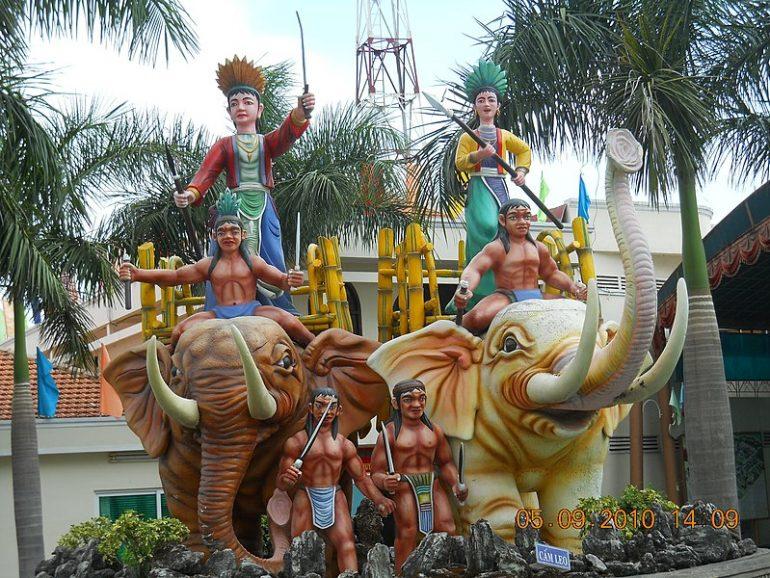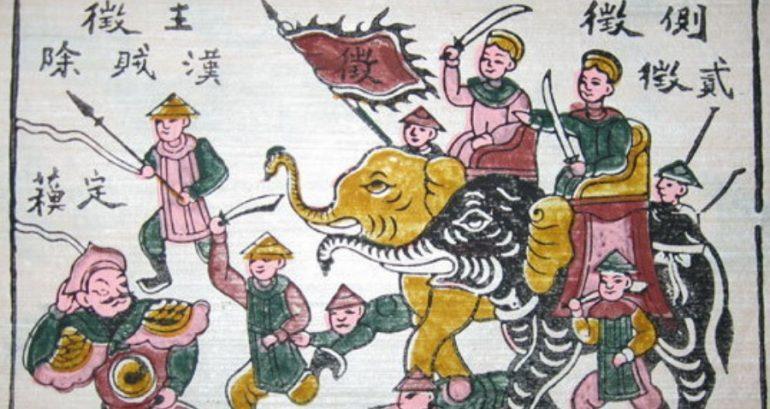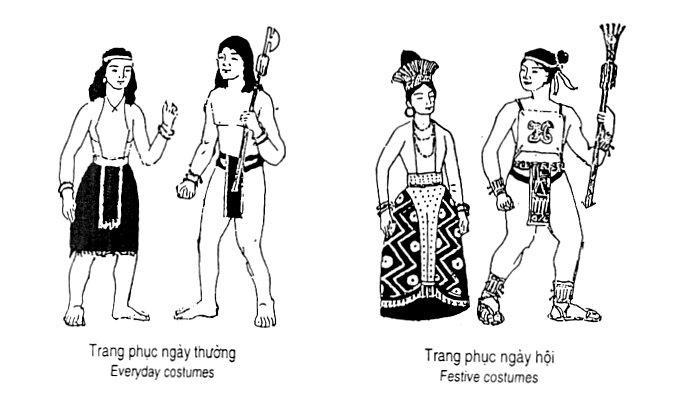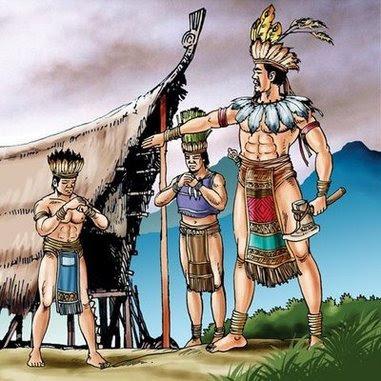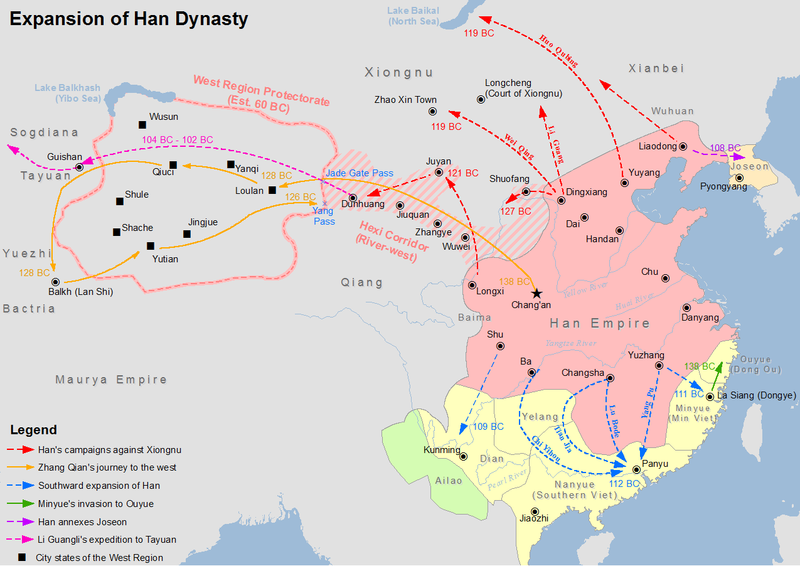Search the Community
Showing results for tags 'vietnam'.
-
we will detail the peoples conquered by the Han Empire. Vietnam. Origin. The Lạc Việt or Luoyue (駱越 ~ 雒越; pinyin: Luòyuè ← Middle Chinese: *lɑk̚-ɦʉɐt̚ ← Old Chinese *râk-wat[1]) was a group of multilinguistic, specificly Kra-Dai and Austroasiatic, tribal peoples that inhabited ancient northern Vietnam, and, particularly the ancient Red River Delta,[2] from ca. 700 BC to 100 AD, during the last stage of Neolithic South East Asia and the beginning of classical antiquity period. From the archaeological perspectives, they were known as the Dongsonian. The Lac Viet was known for casting large Heger Type I bronze drums, cultivating paddy rice, and constructing dikes. The Lạc Việt who owned the Bronze Age Đông Sơn culture, which centered at the Red River Delta (now in northern Vietnam, in mainland Southeast Asia),[3] are proposed to be ancestors of Vietnamese people.[4] Another population of Luoyue, who inhabited the Zuo river's valley (now in modern China), are believed to be ancestors of Zhuang people;[5][6] additionally, Luoyue in southern China are believed to be ancestors of Hlai people. Vietnam under Han. The First Era of Northern Domination refers to the period of Vietnamese history during which present-day northern Vietnam was under the rule of the Han dynasty and the Xin dynasty. It is considered the first of four periods of Vietnam under Chinese rule, the first three of which were almost continuous and referred to as Bắc thuộc ("Northern Domination"). In 111 BC, the powerful Chinese Han dynasty conquered the Nanyue kingdom during its expansion southward and incorporated what is now northern Vietnam, together with much of modern Guangdong and Guangxi, into the expanding Han empire.Vietnamese resistance to Han rule culminated in the rebellion of the Trưng Sisters, who expelled the Han in 40 AD and briefly ruled Vietnam until being defeated by the returning Han Chinese army in 43 AD. Nanyue (Chinese: 南越[1] or 南粤[2]; pinyin: Nányuè; Jyutping: Naam4-jyut6; lit. 'Southern Yue'[3]), was an ancient kingdom ruled by Chinese monarchs[4][5] of the Zhao family that covered the modern Chinese subdivisions of Guangdong,[6] Guangxi,[6] Hainan,[7] Hong Kong,[7] Macau,[7] southern Fujian[8] and central to northern Vietnam.[6] Nanyue was established by Zhao Tuo, then Commander of Nanhai of Qin Empire, in 204 BC after the collapse of the Qin dynasty. At first, it consisted of the commanderies Nanhai, Guilin, and Xiang. Indigenous ways of life and ruling class did not experience major Sinitic impact, into the first century AD.[49][50] It was not until the fourth decade of the first century AD that more direct rule and greater efforts at Sinicization were imposed by the Han dynasty.[50][51] The Han fully consolidated their control, replacing the loosely tribute system by a full Han administration and ruling the region directly as provinces.[52][53] While "some form of nominal northern hegemony was installed",[44] there was no evidence that any Chinese-style enterprise controlled the region during the second or first centuries BC as certain historical accounts are relatively Sinocentric and misleading as to the nature of Proto-Vietnamese society before the "real, later imposition of full Chinese power".[54] https://en.m.wikipedia.org/wiki/Nanyue Following the collapse of the Qin dynasty, Zhao Tuo, a general of the Qin dynasty, took advantage of the Qin’s decline and the South region's crumbling political structure to set up his own kingdom, Nanyue.[7] Nanyue was centered on Panyu (modern-day Guangzhou) and stretched from present-day Vietnam to modern-day Hunan.[8] Despite coming from the North, Zhao Tuo assimilated into the Yue culture and created a new identity as the King of Nanyue. Zhao Tuo identified himself as Yue, married a Yue woman, incorporated locals into his army and even fought off Han invasions later on to protect his kingdom.[8][9] He was able to successfully pull away from his past and make a name for himself in Vietnamese history. Some historians do not see him as a foreign conqueror, but as the defender of Vietnam against the Han Chinese, the legitimacy of the Triệu dynasty would be the source of debate and controversies among Vietnamese historians.[8] Nevertheless, Zhaotuo sought to extend his territory further south to the Red River Delta region. Even with Zhao Tuo’s commitment to assimilate, Chinese influences were still introduced to the Yue people. He brought the Han materialistic culture with him to Nanyue leading to a fusion of Han and Yue art styles in music, handcrafts, and motifs.[10] Artifacts uncovered from the Nanyue Kingdom display the cultural mix between the two cultures, especially from the tomb of Zhao Mo which displayed Han grandeur.[10] Besides Zhao Tuo, the Han court and other Chinese people who migrated to the South have also influenced Yue culture. Despite being autonomous from the Han Dynasty, Chinese influences were still prominent in Nanyue. The kingdom was a vassalage to the Han, and often had to make tributes leading to constant interactions.[10] Furthermore, the Nanyue kingdom’s elites were a mix of Northern people who moved to the south and the former Yue elite bringing a mixing of cultures.[8] The elites during this time became culturally dual and would later take advantage of their skills during the Han conquest as the link between the Yue and Han Chinese.[9] One of the main reasons why the Yue culture became so heavily intermingled with Chinese culture was because there were not definitive borders that declared where the southernmost region of China ended and where the territory of the Yue peoples began. Chinese farmers were compelled to move farther and farther south because the climate and terrain were more conducive for their crops. As they crossed the seemingly imaginary border, more and more farmers became acquainted with the Yue peoples and their cultures. This indefinite border made it so that the Chinese culture and the Yue peoples intersected and influenced each other. This would eventually be a contributing factor for why the Chinese empires would travel south to conquer the Yue peoples and assume their land.[9] Due to the fact that the Han Dynasty did not keep detailed records of the personal and cultural identities of the Yue people, a lot of information now known is in relation to their political and governmental roles that the Imperial Han court came into contact with by means of trade and colonization.[3] Those who were referred to as Yue may not have claimed the identity signifier for themselves, so much as that it was a term placed onto them and their culture by outside forces. There is not one “Yue” culture as the term encompassed several different groups of people with varying cultural identities that ranged all throughout the East Asian mainland and what is now considered the southern Chinese Provinces and Northern Vietnam. People native to the southernmost territories were referred to as the “Hundred Yue” which references the numerous different cultures included in this one identity. In 196 BC, Emperor Gaozu sent Lu Jia on a diplomatic mission to Nanyue to officially recognize Zhao Tuo.[11] Nevertheless, relations between Han and Nanyue were sometimes strained.[12] Zhao Tuo resented Empress Lü's ban on exports of metal wares and female livestock to Nanyue.[12] In 183 BC, he proclaimed himself the "Martial Emperor of the Southern Yue" (南越武帝), which implied a perceived status on equal footing with the Han emperor.[13] Two years later, Nanyue attacked the Changsha Kingdom, a constituent kingdom of the Han empire.[13] In 180 BC, Lu Jia led a diplomatic mission to Nanyue that succeeded in convincing Zhao Tuo to give up on his title as emperor and pay homage to Han as a nominal vassal.[12] In 135 BC, King Zhao Mo of Nanyue appealed to the Han court for help against attacking Minyue forces.[14] The Han court responded swiftly and this led to Zhao Mo's agreement to send his son, Prince Zhao Yingqi, to serve in the palace at Chang'an.[15] At the Nanyue court in 113 BC, the Queen Dowager of Nanyue suggested incorporating Nanyue as a kingdom under the suzerainty of the Han empire, thus formally integrating the kingdom on the same terms as the other kingdoms of the Han empire.[15] She was Chinese herself and was married to Zhao Yingqi.[15] However, many Nanyue ministers opposed this suggestion.[15] Lü Jia was the primary Nanyue official to oppose the idea and he led the opposition against the Queen Dowager.[14] In 112 BC, the opposition retaliated violently and executed the Queen Dowager, a provocation that led to the mobilization of a large Han naval force into Nanyue.[14] The Han forces comprised six armies, who traveled by sea, directly southward, or from Sichuan along the Xi River.[16] In 111 BC, General Lu Bode and General Yang Pu advanced towards Panyu (present-day Guangzhou).[14] This resulted in the surrender of Nanyue to the Han empire later that year.[14] Sinicization During the next several hundred years of Chinese rule, sinicization of the newly conquered Nanyue was brought about by a combination of Han imperial military power, regular settlement and an influx of Han Chinese refugees, officers and garrisons, merchants, scholars, bureaucrats, fugitives, and prisoners of war.[17][18] At the same time, Chinese officials were interested in exploiting the region's natural resources and trade potential. In addition, Han Chinese officials seized fertile land conquered from Vietnamese nobles for newly settled Han Chinese immigrants.[19][20] Han rule and government administration brought new influences to the indigenous Vietnamese and the rule of Vietnam as a Chinese province operated as a frontier outpost of the Han Empire.[21][1] The Han dynasty was desperate to extend their control over the fertile Red River Delta, in part as the geographical terrain served as a convenient supply point and trading post for Han ships engaged in the growing maritime trade with various South and Southeast Asian Kingdoms as well as establishing it as a prominent trading post with India and the Roman Empire.[22][23][24] The Han dynasty relied heavily on trade with the Nanyue who produced unique items such as: bronze and pottery incense burners, ivory, and rhinoceros horns. The Han dynasty took advantage of the Yue people’s goods and used them in their maritime trade network that extended from Lingnan through Yunnan to Burma and India.[9] During the first century of Chinese rule, Vietnam was governed leniently and indirectly with no immediate change in indigenous policies. Initially, indigenous Lac Viet people were governed at the local level but with indigenous Vietnamese local officials being replaced with newly settled Han Chinese officials.[25][26] Han imperial bureaucrats generally pursued a policy of peaceful relations with the indigenous population, focusing their administrative roles in the prefectural headquarters and garrisons, and maintaining secure river routes for trade.[27] By the first century AD, however, the Han dynasty intensified its efforts to assimilate its new territories by raising taxes and instituting marriage and land inheritance reforms aimed at turning Vietnam into a more amenable to political authority. The native Luo chief paid heavy tributes and imperial taxes to the Han mandarins to maintain the local administration and the military.[25] The Chinese vigorously tried to assimilate the Vietnamese either through forced sinification or through brute Chinese political domination.[21] The Han dynasty sought to assimilate the Vietnamese as the Chinese wanted to maintain a unified cohesive empire through a "civilizing mission" as the Chinese regarded the Vietnamese as uncultured and backward barbarians with the Chinese regarding their "Celestial Empire" as the supreme centre of the universe. Trung sisters' uprising In March 40 AD, the Trưng sisters, Trưng Trắc (徵側; Zheng Ce) and Trưng Nhị (徵貳; Zheng Er), led the Lac Viet people to rise up in the Trưng sisters' rebellion against the Han in Jiaozhi.[33][34] It began at the Red River Delta, but soon spread to other Yue tribes along the coast to the north and south.[33] The uprising gained the support of about sixty-five towns and settlements.[34] Trung Trac was proclaimed as the queen.[33] Even though she gained control over the countryside, she was not able to capture the fortified towns.[33] A military campaign led by Han general Ma Yuan from 42 AD to 43 AD led to the Han reconquest of the region, leading to the capture and decaptiation of the Trưng sisters and the start of the Second Chinese domination of Vietnam. https://en.m.wikipedia.org/wiki/First_Era_of_Northern_Domination The Trưng sisters' rebellion was an armed civil uprising in the south of Han China between 40 and 43 AD. In 40 AD, the Vietnamese leader Trưng Trắc and her sister Trưng Nhị rebelled against Chinese authorities in Jiaozhi (in what is now northern Vietnam). In 42 AD, Han China dispatched General Ma Yuan to lead an army to strike down the Yue rebellion of the Trưng sisters. In 43 AD, the Han army fully suppressed the uprising and regained complete control. The Trưng sisters were captured and beheaded by the Han forces,[8][9] although Vietnamese chronicles of the defeat records that the two sisters, having lost to Han forces, decided to commit suicide by jumping down the Hát Giang river, so as not to surrender to the Han.[10][11][12] –The Trưng sisters' rebellion, anachronistic depicted in a Đông Hồ folk painting. The image of the Trưng sisters riding elephants is commonly found in most folk depictions of the rebellion.- One prominent group of ancient people in Northern Vietnam (Jiaozhi, Tonkin, Red River Delta region) during the Han dynasty's rule over Vietnam was called the Lac Viet or the Luòyuè in Chinese annals.[13] The Luoyue had been indigenous to the region. They practiced non-Chinese tribal ways and slash-and-burn agriculture.[14][15] According to French sinologist Georges Maspero, some Chinese immigrants arrived and settled along the Red River during the usurpation of Wang Mang (9–25) and the early Eastern Han, while two Han governors of Jiaozhi Xi Guang (?-30 AD) and Ren Yan, with support from Chinese scholar-immigrants, conducted the first "sinicization" on the local tribes by introducing Chinese-style marriage, opening the first Chinese schools, and introducing Chinese philosophies, therefore provoked cultural conflict.[16] The Trưng sisters were daughters of a wealthy aristocratic family of Lac ethnicity.[17] Their father had been a Lac lord in Mê Linh district (modern-day Mê Linh District, Hanoi). Trưng Trắc (Zheng Ce)'s husband was Thi Sách (Shi Suo), was also the Lac lord of Chu Diên (modern-day Khoái Châu District, Hưng Yên Province).[18] Su Ding (governor of Jiaozhi 37–40), the Chinese governor of Jiaozhi province at the time, is remembered by his cruelty and tyranny.[19] According to Hou Hanshu, Thi Sách was "of a fierce temperament".[20] Trưng Trắc, who was likewise described as "possessing mettle and courage",[21] fearlessly stirred her husband to action. As a result, Su Ding attempted to restrain Thi Sách with laws, literally beheading him without trial.[22] Trưng Trắc became the central figure in mobilizing the Lac lords against the Chinese.[23] The Book of the Later Han recorded that Trưng Trắc launched the rebellion to avenge the killing of her husband.[6] It began at the Red River Delta, but soon spread to other Lạc and non-Han peoples from an area stretching from Hepu Commandery to Rinan.[5] Chinese settlements were overrun, and Su Ding fled.[10] The uprising gained the support of about sixty-five towns and settlements.[12] Trưng Trắc was proclaimed as queen regnant.[11] In 42 CE, the Han emperor commissioned general Ma Yuan to suppress the rebellion with 20,000 troops. The rebellion of the two sisters was defeated in the next year as Ma Yuan captured and decapitated Trưng Trắc and Trưng Nhị, then sent their heads to the Han court in Luoyang.[14] The Song dynasty poet and calligrapher Huang Tingjian (1045–1105) compared the Trưng sisters to Lü Jia, the prime minister of Nanyue who resisted Han Wu Di's army in 112 BCE: Lü Jia refused treasonous brides; Trưng Trắc raised her shield to resist oppression[15] The Han government (situated in Luoyang) responded rather slowly to the emerging situation.[8] In May or June of 42 AD, Emperor Guangwu gave the orders to initiate a military campaign. The strategic importance of Jiaozhi is underscored by the fact that the Han sent their most trusted generals, Ma Yuan and Duan Zhi to suppress the rebellion.[25] Ma Yuan was given the title Fubo Jiangjun (伏波將軍; General who Calms the Waves).[8] He would later go down in Chinese history as a great official who brought Han civilization to the barbarians.[25] Ma Yuan and his staff began mobilizing a Han army in southern China.[8] It consisted 20,000 regulars and 12,000 regional auxiliaries.[9][26] From Guangdong, Ma Yuan dispatched a fleet of supply ships along the coast.[8] In the spring of 42, the imperial army reached high ground at Lãng Bạc, in the Tiên Du mountains of what is now Bắc Ninh. Yuan's forces battled the Trưng sisters, beheaded several thousand of Trưng Trắc’s partisans, while more than ten thousand surrendered to him.[27] The Chinese general pushed on to victory. During the campaign he explained in a letter to his nephews how “greatly” he detested groundless criticism of proper authority. Yuan pursued Trưng Trắc and her retainers to Jinxi Tản Viên, where her ancestral estates were located; and defeated them several times. Increasingly isolated and cut off from supplies, the two women were unable to sustain their last stand and the Chinese captured both sisters in early 43.[28] Trắc’s husband, Thi Sách, escaped to Mê Linh, ran to a place called Jinxijiu and was not captured until three years later.[27] The rebellion was brought under control by April or May.[8] Ma Yuan decapitated Trưng Trắc and Trưng Nhị,[8][9] and sent their heads to the Han court at Luoyang.[27] By the end of 43 AD, the Han army had taken full control over the region by defeating the last pockets of resistance.[8] Yuan reported his victories, and added: “Since I came to Jiaozhi, the current troop has been the most magnificent."[27]

.thumb.png.ce58cea22940c255f5b0a735d5abee36.png)
